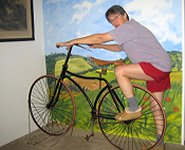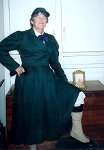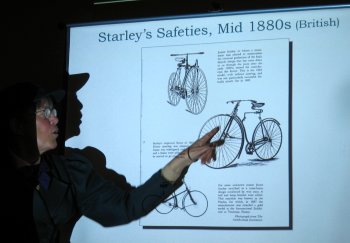- By Dan Veaner
- Around Town
 Print
Print  Visitors to the Lansing Community Library were transformed to the 1880s Tuesday as Donna Scott told them about the history and heyday of bicycles. Scott, a long-time bicycle collector and historian, created an experience for the packed exhibit room that included period costume, actual historic bicycles, posters and a history wall based on her presentation. Scott says Eagle high wheeled bicycles in particular took more skill than modern bikes. "To get on those babies you've got to race down the road and be really agile and get that pedal when it's down in the right place and fling yourself on," she says. "Only very athletic people can get on them."
Visitors to the Lansing Community Library were transformed to the 1880s Tuesday as Donna Scott told them about the history and heyday of bicycles. Scott, a long-time bicycle collector and historian, created an experience for the packed exhibit room that included period costume, actual historic bicycles, posters and a history wall based on her presentation. Scott says Eagle high wheeled bicycles in particular took more skill than modern bikes. "To get on those babies you've got to race down the road and be really agile and get that pedal when it's down in the right place and fling yourself on," she says. "Only very athletic people can get on them."When the library's art show director Janice Hagstrom learned that Scott has a collection the two began talking about an exhibit. Scott was loath to leave them at the library until after the capital project that rendered the building more secure. Hagstrom wanted an art show to go with the bicycles. "What she hit upon was this bicycle poster book," Scott says. "It has 100 posters advertising bicycles and tricycles, mostly from the 1890s, but a few from the 1880s. They are all art nouveau or similar styles from that period."
Scott has given presentations in the past, but this is the first she has given for for many years. She conducted extensive research and created Powerpoint slides to illustrate it. The earliest bicycle was invented in about 1816. Scott says that the German Baron von Drais invented what he called a laufmaschine, which was called a hobby horse in England, and in France a Draisine. The device looked a lot like a modern bicycle without the pedals. A rider would sit on it and push along with his feet.

After the 1890s pontoon bicycles were introduced. Scott has one that dates from after World War II. "It's my most favorite water toy," Scott says. "You can ride all over the lake."
In the United States bicycles were imported from England at first, but as they became popular here Albert Pope started making them here, starting the Columbia Bicycle Company. Bicycles were a craze in the 1880s. Thomas Stevens rode his bike around the world in 1884. He described his journey in the two volume 'Around the World on a Bicycle, which he published in 1886 and 1887.
At least 22 women in the US who were regular high wheel racers in the 1880s. They made a living racing -- some did 1000 miles on a track. Elsa von Blumen was the stage name of one such racer from Rochester. Scott based her riding costume on von Blumen's. It was built by the costume designer for the Genesee County Museum, reproducing the 1880s design. It features a modesty skirt over knickers. Another riding dress was taken from an 1894 pattern."
 Scott demonstrates how to mount a historic bicycle |  Janice Hagstrom manages the art shows in the library gallery |
 Scott's costumes are reproductions of authentic women's riding gear. She has worn them in parades at the Genesee County Museum and other events, including Tuesday's presentation. Bicycling became such a craze that it strongly influenced women's fashion. "If you had knickers, when you got off the bike and were walking around it would be too scandalous," she notes. "You'd be showing that you had legs! With the divided skirt and buttons to pull it up while you pedal, you would unbutton it and pull it down like a skirt when you were walking on the street. There were bloomers under it, and stockings and shoes or boots, and gators over the shoes and stockings. A jacket, vest, blouse and corset were part of it, and a hat topped it off."
Scott's costumes are reproductions of authentic women's riding gear. She has worn them in parades at the Genesee County Museum and other events, including Tuesday's presentation. Bicycling became such a craze that it strongly influenced women's fashion. "If you had knickers, when you got off the bike and were walking around it would be too scandalous," she notes. "You'd be showing that you had legs! With the divided skirt and buttons to pull it up while you pedal, you would unbutton it and pull it down like a skirt when you were walking on the street. There were bloomers under it, and stockings and shoes or boots, and gators over the shoes and stockings. A jacket, vest, blouse and corset were part of it, and a hat topped it off.""Bicycles were expensive," Scott says. "It's not like now when every household has some kind of bicycle. In the 1880s they ranged from $100 to $150 depending on the model. This was when people made a dollar or less per day for a 12 hour work day. Only well off people could afford them, but thousands were sold in Europe and the United States."
Scott became interested in bicycles in the late 1960s when she met her ex-husband. "He was already interested in bicycles. He'd see high wheelers in shops in New york city and he always wanted one," she recalls. "When I moved to Philadelphia in 1968 my housemate started dating a guy who was one of the charter members of the Wheelmen. He got us our first high wheeler, which I still have. That is the one that I used to ride."

The couple restored bicycles in their collection, which numbered over 50, and for others, including a high wheeled bicycle at the Tompkins County History Center. "We decided not to restore my high wheeled bike, because it has a little of its original nickle on it," she says. "And I was always using it because it's a good, easy-riding one."
Today she owns five bicycles of different types that represent the history of the devices. All of her bicycles are ridable except for one for which tires are no longer available. The others have hard rubber tires except a girl's tricycle which doesn't have tires. That one is the most recent, from 1896. Scott thinks her 'ordinary' high wheel bike is the oldest, from about 1888. "That was a time when bicycle development was changing very rapidly," Scott says. "Most of the development took place in England, and then it would come to America."
Scott says that with the price of gas today bicycling remains a viable and thrifty means of transportation. She recalls that when she worked at Cornell she would bicycle to work wearing a shirt with the slogan, 'Don't laugh. I get 35 miles to the peanut butter and jelly sandwich.' "It just shows how efficient and economical a bicycle is," she notes. "You get good exercise and get in shape, and you don't use any gas."
The exhibit will run for three weeks. The actual bicycles will be on display for the first week an a half, and Scott says she will be there often to answer questions.
----
v4i22



